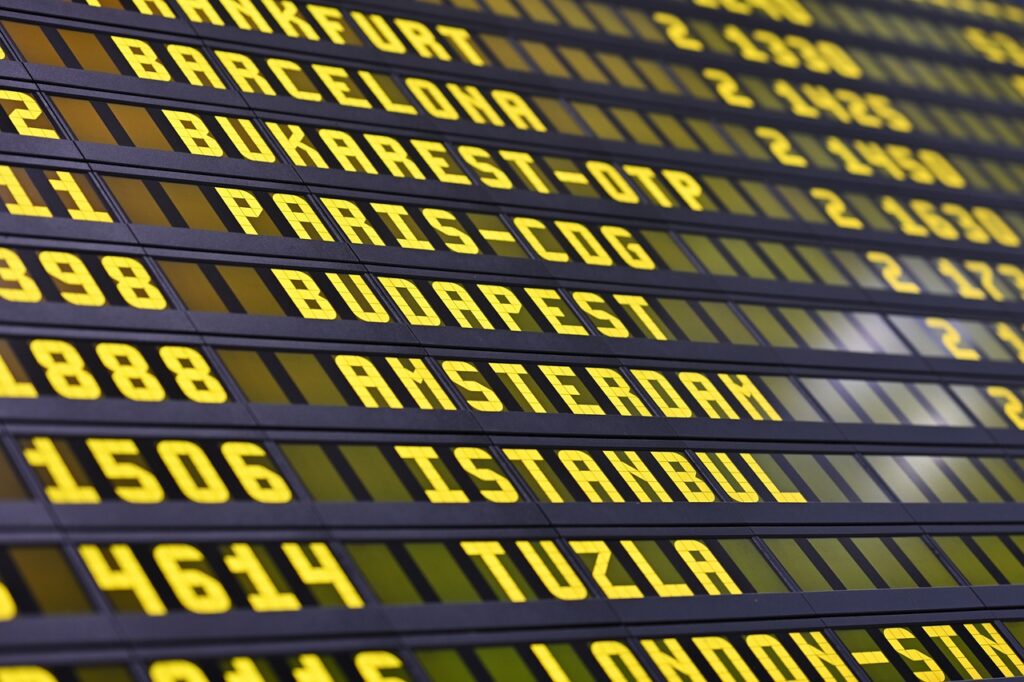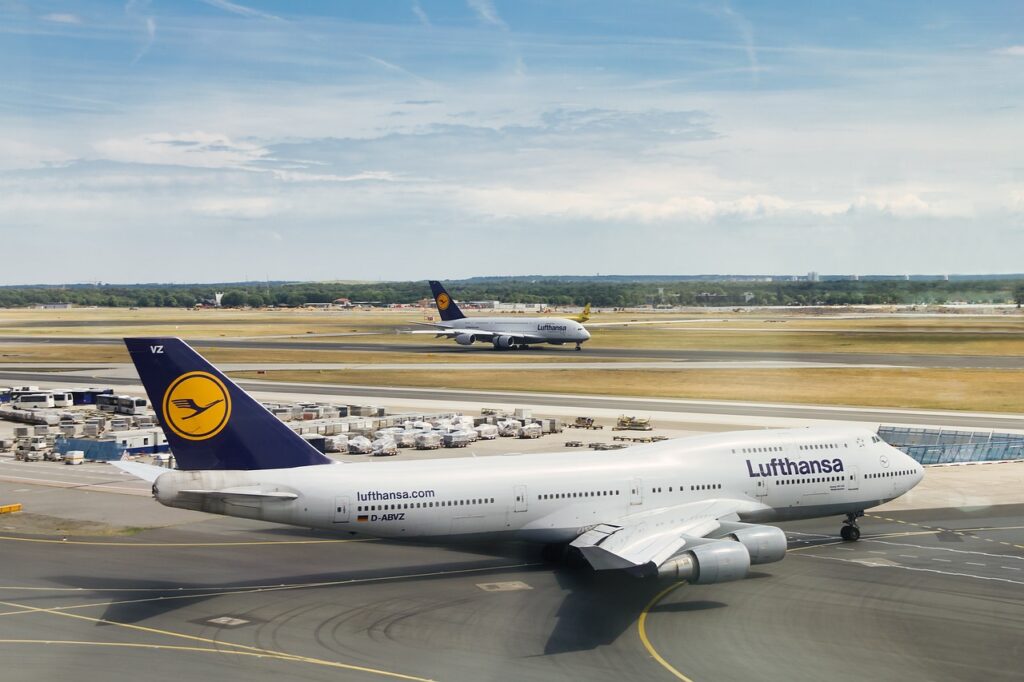There are a lot of unknowns when traveling overseas. International flights can be a maze of unfamiliar processes.
From deciphering announcements to navigating security checkpoints and customs procedures, the challenges can seem overwhelming.

However, knowing how to efficiently navigate airports can transform your journey from stressful to smooth.
These ten essential tips will help you breeze through international airports like a seasoned globetrotter, saving time, money, and unnecessary headaches.
Tip #1: Listen for English Announcements
When taking international flights, remember that English is widely used in airports worldwide. In foreign airports, announcements are typically repeated in English after the local language.
This also applies to airplanes, where about 90% of announcements are made in English as well. (after the local language is said)
So, if you’re a native English speaker traveling overseas, don’t worry about language barriers in airports or on planes. If you don’t understand the first announcement, just wait a moment. The English version is likely coming up next, helping you stay informed throughout your journey.
Tip #2: Navigating Entry and Transfers on International Flights Airports
When transferring on international flights and in foreign airports, remember: if you’re not entering the country, you don’t go through immigration or customs.
Instead, look for signs saying “Transfer Passengers” or “Transfers.” Often, there’s a sign saying one way to baggage claim and another way for ongoing passengers.
There are exceptions (like entering the US), but generally, when traveling overseas, head for the transfer hall. This can save you time and stress.
I once waited 45 minutes in an immigration line in Serbia. When I got to the window, I was told I should have gone to the transfer area. I missed my connecting flight.
Learn from my mistake: if you’re just transferring, follow the transfer signs to avoid missed connections.
Is talked about this in detail in How to Not Miss Your Connecting Flight
Tip #3 Duty Free Shopping
Duty-free shops can offer significant savings, but timing is key. Buy on your way out of a country, not in, to avoid liquid restrictions on connecting flights.
Be aware of duty-free allowances for your destination – exceeding these can result in hefty taxes.
A little-known fact: some airports, like Singapore’s Changi, offer duty-free pre-order services where you can shop online and pick up your items upon return.
Tip #4: Airport Security
When traveling abroad, you’ll often find that airport security is less stringent than in the United States.
In many foreign airports, you might not need to remove your shoes when going through security checkpoints.
Additionally, some countries don’t require you to take liquids out of your bag for separate screening. However, it’s important to note that most countries do enforce liquid limits similar to the U.S. (usually around 3.4 oz or 100 ml per container).
Overall, the security process in many countries outside the U.S. tends to be more pleasant and less time-consuming than here in the U.S.
Tip #5: Airport Lounges on International Flights
You don’t need to be a frequent flyer to access lounges. Many credit cards offer lounge access as a perk, or you can purchase one-time passes. Benefits often include comfortable seating, free food and drinks, showers, and sometimes even spa services. Often the WiFi is better in the lounges.
For me, the best thing about lounges is most have showers.

Tip #6: Master the Art of Currency Exchange
Airport kiosks typically offer poor exchange rates. Even so, I always get about $50 of the local currency before I leave the airport – just in case I need to take a taxi.
But I only use ATMs because they give better rates.
Whatever you do, don’t go to the Currency Exchange windows because you’ll get terrible rates. When I say terrible rates, I mean that in addition to the real exchange rate, the rate at the window will be even worse.
For example, let’s say the Euro is a bit stronger than the dollar at 1.10 to 1.00. At the currency exchange window, it might be 1.35 to 1.00. Now you pay $135 and get $100.
So don’t exchange money at the airport.
Tip #7: Take Advantage of Free Airport Wi-Fi
Most international airports offer free Wi-Fi, but connection methods vary. Some require you to watch an ad, while others need a code from an information desk.
Download the airport’s official app for easy access and additional features like real-time gate information.
If you frequently take international flights and are worried about security, use a VPN when you’re on public Wi-Fi.
Fun fact: Seoul’s Incheon Airport and the Tallinn, Estonia airport offer some of the fastest free airport Wi-Fi in the world.
Tip #8: Know Your Gate’s Location Gate
My favorite travel item is my Bose Quiet Comfort Noice Canceling headphones. But be careful in airports because you need to hear what’s going on.
Gates changes are more common than you might think. Just because your flight is leaving out of one gate, doesn’t mean an hour later its not moved.
Check information boards frequently, especially for connecting flights. In massive airports like London Heathrow, you might need to take a train between terminals, so allow extra time.
Tip #9: Use Self-Service Kiosks
If you fly domestically, you’re probably familiar with airport check-in kiosks Many international flights now offer self-check-in and bag drop services, which can be significantly faster than waiting for an agent. But not all airports do.
Note: Especially for international flights with visa checks, you often can’t self-check-in.
Tip #10: Be Prepared for Customs of International Flights
Filling out declaration forms accurately is crucial. Know the duty-free limits and restricted items for your destination country. A useful tip: many countries now offer mobile apps or online forms for customs declarations, allowing you to complete them before landing.
Bonus Tip: Learn Airport Codes
While not essential, knowing airport codes can be helpful and fun. (Obviously, you can Google these, but knowing them on the fly is convenient)
For example, ORD for Chicago O’Hare has nothing to do with its name – it comes from the area’s original name, Orchard Field. Some codes are intuitive (LAX for Los Angeles), while others are puzzling (MCO for Orlando, which comes from its former name, McCoy Air Force Base).
Conclusion
By mastering these airport navigation skills, you’ll not only reduce stress but also open up opportunities to enjoy the unique features many international airports offer. From butterfly gardens in Singapore’s Changi to an in-airport brewery at Munich’s Franz Josef Strauss, airports can be destinations in themselves when you know how to navigate them efficiently.
Have fun!
Derron

1 thought on “10 Tips for Smooth International Flights”
Comments are closed.